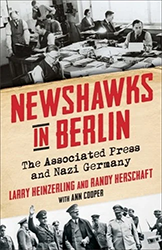In 1979, when Belgian author Stefan Hertmans decided to rent a damp old house on the banks of the sludgy Lieveke canal in a rundown neighborhood of Ghent, he wasn’t thinking about its previous inhabitants. The young, penniless writer was more interested in having the space so that his artistic friends could gather, sing protest songs, and philosophize. And he hoped that the “vague drawings on the walls made by stains” and the electrical wires “creeping through the Bakelite sockets like spider legs” would mean cheap rent.
But many years after he left the three-story house — with its dusty attic, chipped marble fireplace, and uncooperative locks — he learned that, during World War II, it was occupied by Willem Verhulst, an SS intelligence officer. Hertmans, by then a successful writer, found a memoir by Verhulst’s son Adriaan, who had become a prominent historian.
Hertmans, whose first novel to be translated into English, War and Turpentine, was named one of the ten best books of the year by the New York Times, set off on a quest. Straddling the line between nonfiction and fiction, he delves into long-neglected archives and seeks out interviews with relatives, neighbors, and aging veterans while also exercising his imagination. In doing so, he presents a gripping tale of the house on Drogenhof Street, which contains both his own memories and the secrets of the SS officer and his family.
Using the house as a framework, the author provides a visceral sense of life in the occupied city during the war, where, in a country already split between Walloons and Flemish, residents are bitterly divided. On the eve of World War II, Verhulst, a right-wing Flemish nationalist, moves to Ghent with his wife, Mien — a Dutch farmer’s daughter — and their three children. He works as a traveling salesman for a radio equipment distributor, a post that will prove important when the Germans invade in early May 1940. By the end of May, the Belgian army will surrender.
When the Germans take over the radio station, Verhulst — with his knowledge of radio transmission and his sympathy for the German cause — is offered the directorship of Radio Flanders. He is thrilled with the propaganda broadcasts of “marching music, Flemish choirs and blustering speeches.” He also earns a fat salary of 15,000 francs a month, while most families in Ghent cannot afford salt. He installs a bust of the Fuhrer on his marble mantlepiece and dons an SS uniform, much to his wife’s dismay. She makes him change into a suit whenever he enters the house.
Though Verhulst was rejected for military service because he has only one eye (due to a childhood illness), he becomes a confidential agent for the SS, officially known as a Vertrauensmann, or V‑mann. His duty is to compile lists for Nazi intelligence of Jews, suspected members of the resistance, socialists, enemies of the Volk, and “even the Boy Scouts because of their pacifist philosophy.” Some of the people he targets are sent for interrogations and brutal beatings, while others are deported to Buchenwald. He sits “upstairs in his office, only vaguely aware of the screams from the cellars, ignorant of the details, that’s none of his business.”
The Ascent is beautifully translated by David McKay, who won the 2017 Vondel Prize for translating Hertmans’s earlier novel. However, because the book is written for a Belgian audience, the author assumes that his readers understand the political and cultural divisions between the French-speaking Walloons and the Dutch-speaking Flemish in Belgium — circumstances that many English-speaking readers may not be familiar with. It would have been helpful to have an introduction that explains this historical context.
Hertmans’s parallel stories of Verhulst’s treachery and his own path to uncovering the secrets hidden in the Drogenhof house make for a compelling read. The records he finds in the national archives of Verhulst’s postwar prosecution as a collaborator are shocking. As the author leafs through “seven large cardboard boxes piled high with half-decayed paper, dog-eared manuscripts, flimsy carbon copies, penciled notes … stamped SECRET,” the reader can hardly wait to find out what he discovers.
Elaine Elinson is coauthor of the award-winning Wherever There’s a Fight: How Runaway Slaves, Suffragists, Immigrants, Strikers, and Poets Shaped Civil Liberties in California.





